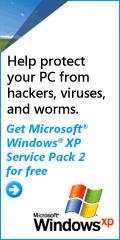Circuit Rider
Version 4.1
By Jim Scheef
Net Neutrality
This topic will not go away,
and if you think it’s bad now, wait
until we’re all moaning about it after the fact. Call your Congresspeople and tell them you want the Internet to remain free (as in free speech). If they respond that the issue is not about free speech, tell them you don’t want AT&T or Verizon deciding whose web site or blog gets into the “fast lane.” Tell them we like the Internet like it is, and do not want to suffer the same fate as the people of China or Saudi Arabia where Internet content is most definitely filtered. Call them now, before it’s too late.
XP System Recovery
Did you know that there is a “DOS” buried in XP? No, not the command window you get when you run cmd.exe, but what amounts to a stand alone operating system that boots to a command line. This is an enhanced version of the Recovery Console found on the XP setup CD (but only if you know where to look for it). Information Week readers may have seen Fred Langa’s columns in April and May on this and other “free” system recovery tools. I use quotes here, because this mini-OS is part of XP and thus is included in your XP license. The jury is still out on whether this is easier to set up and use than Bart PE.
You can find Fred’s articles on the
Information Week web site at www. informationweek.com. Then search for article number 187000225. From there you can surf to related articles.
Twenty Something
Network World magazine had its twentieth anniversary a few months back. I always enjoy these retrospective issues, and this one was pretty good. Of course they are oriented to networking rather than general computing, and this is reflected in their lists. I thought they made some really good picks. Here are shortened versions of two of their lists with my paraphrased descriptions.
People who changed the networking industry:
1. Mark Andreessen: created a user-friendly, graphical browser in 1993 called NCSA Mosaic for X Window System; later co-founded Netscape.
2. Tim Berners-Lee: dreamed of a universal, easy-to-use information system and
invented the World Wide Web.
3. Vint Cerf: hailed for his role in defining the protocols (like IP and TCP) that made it possible to link research networks to form the ARPANet, the precursor of today’s Internet.
4. Jon Postel: created the framework for Internet standards that we now call RFCs, and did so in a way to ensure they would be open standards.
5. Laurie Bride: enterprise architect at Boeing who showed the need to interconnect disparate computing systems using open standards like Open Systems Interconnection model and TCP/IP.
6. Bill Gates: you know…
7. Lou Gerstner: forged the services industry based on open standards, the Internet, e-business and Linux; led IBM from struggling has-been back to powerhouse.
8. Linus Torvalds: made open source a household word . . . oh . . . and created Linux in the process.
9. Scott McNealy: drove the idea of the networked environment and seamless connectivity; made Java something other than coffee.
Stories that change the industry:
1. 2003 - Slammer lays down the hammer: the world was so unprepared, that Chase Bank had to shut down their online banking.
2. 1999 Microsoft’s monopoly: U.S. Judge Thomas Penfield Jackson ruled that Microsoft is a monopoly; but the settlement three years later did not change the way the company does business.
3. 1998 Netscape sells out: Beaten by Microsoft, Netscape gave up going it alone and sells to AOL, who fails to capitalize on deal.
4. 1998 No more DEC: Compaq pays $9.6 billion for the once-dominant minicomputer maker and splits the assets among Cabletron, Intel and Oracle. DEC completely disappears in the subsequent merger between HP and Compaq.
5. 1997 Cutting the cords with Wi-Fi. The 802.11 standard is released leading to an entire new industry segment, plus hot spots, and war driving.
6. 1996 Reforming telecom. Congress passes the Telecommunications Act of 1996, leading to all the unintended consequences we have today.
7. 1995 Microsoft discovers the Internet. Bill Gates issues his famous “The Internet Tidal Wave” memo, formally recognizing the Web’s potential a few years after many others did. Still, Microsoft was able to catch up in a hurry.
8. 1995 Ethernet everywhere. Ethernet moved from 10 to 100bps pushing aside token ring and other technologies while forcing down prices.
9. 1991 Linux is born. Linus Torvalds releases the Linux kernel as open source software.
10. 1990 OS/2 vs. Windows. Microsoft and IBM split on OS/2 and Windows development starting the OS/2 slide to oblivion.
11. 1989 Welcome to the Web. Physicist Tim Berners-Lee creates HTML and the World Wide Web, paving the way for Marc Andreessen and the rest.
12. 1988 Hinsdale burns. A fire in Illinois Bell’s Hinsdale central office (about 10 miles from where I grew up) damaged most of the 50,000 circuits supported by the switch. The incident provided a wake-up call about disaster recovery at carriers and corporate IT shops.
13. 1986 E-mail gets connected. MCI Mail and CompuServe link their e-mail networks - the beginning of the end to the question “Where is your email account?”
Jim Scheef is past president of DACS.
|
